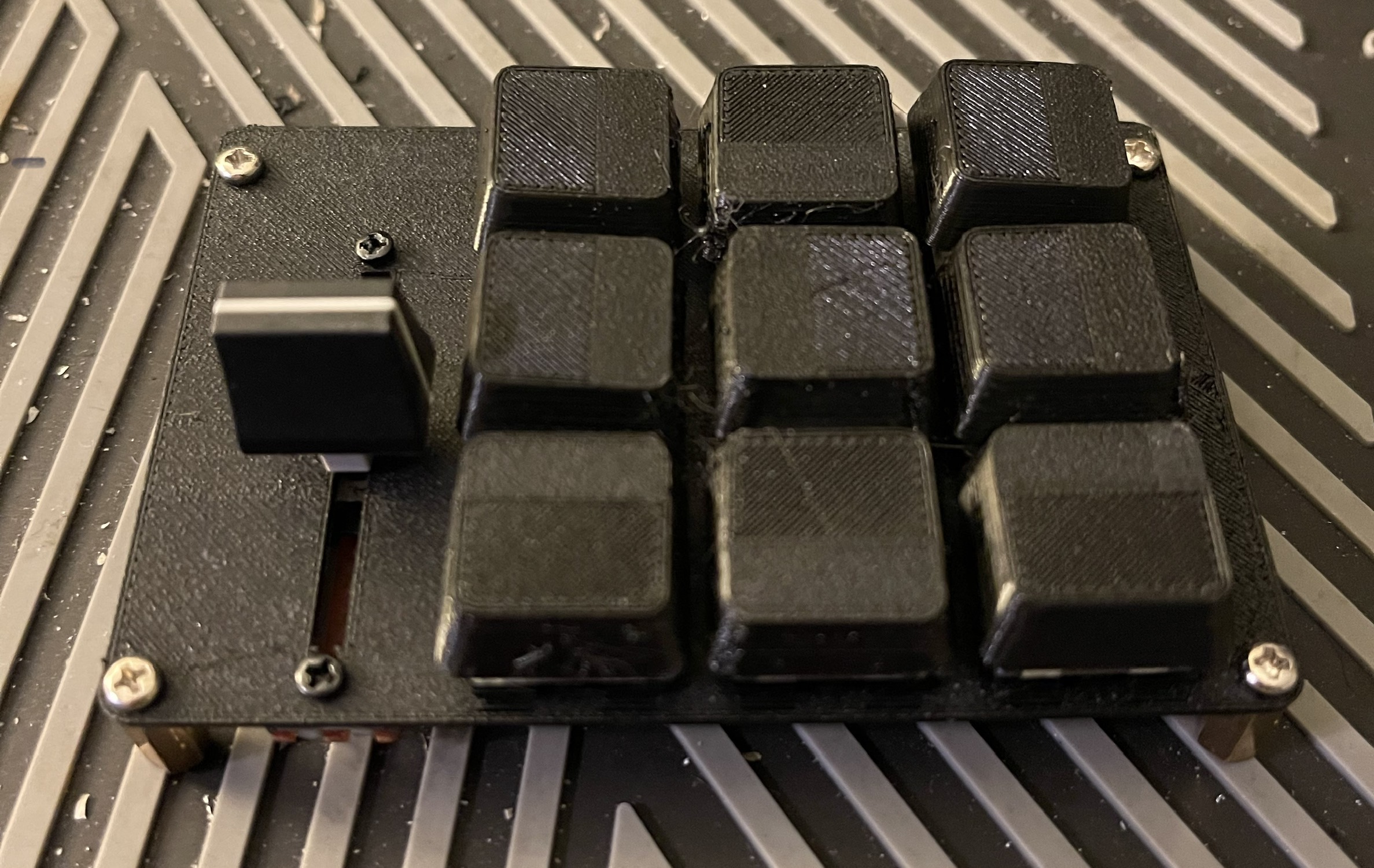-
-
Save sandyjmacdonald/804dc737e7cb798d1b4fa34adc87e2d4 to your computer and use it in GitHub Desktop.
| import time | |
| import board | |
| import busio | |
| import usb_midi | |
| import adafruit_midi | |
| from adafruit_midi.note_off import NoteOff | |
| from adafruit_midi.note_on import NoteOn | |
| from adafruit_bus_device.i2c_device import I2CDevice | |
| import adafruit_dotstar | |
| from digitalio import DigitalInOut, Direction, Pull | |
| # RGB MIDI controller example for Pimoroni RGB Keypad for Raspberry Pi Pico | |
| # Prerequisites | |
| # | |
| # Requires Adafruit CircuitPython: https://learn.adafruit.com/getting-started-with-raspberry-pi-pico-circuitpython | |
| # | |
| # Also requires the following CircuitPython libs: adafruit_midi, adafruit_bus_device, adafruit_dotstar | |
| # (drop them into the lib folder) | |
| # | |
| # Save this code in code.py on your Raspberry Pi Pico CIRCUITPY drive | |
| # Pull CS pin low to enable level shifter | |
| cs = DigitalInOut(board.GP17) | |
| cs.direction = Direction.OUTPUT | |
| cs.value = 0 | |
| # Set up APA102 pixels | |
| num_pixels = 16 | |
| pixels = adafruit_dotstar.DotStar(board.GP18, board.GP19, num_pixels, brightness=0.1, auto_write=True) | |
| # Set up I2C for IO expander (addr: 0x20) | |
| i2c = busio.I2C(board.GP5, board.GP4) | |
| device = I2CDevice(i2c, 0x20) | |
| # Set USB MIDI up on channel 0 | |
| midi = adafruit_midi.MIDI(midi_out=usb_midi.ports[1], out_channel=0) | |
| # Function to map 0-255 to position on colour wheel | |
| def colourwheel(pos): | |
| if pos < 0 or pos > 255: | |
| return (0, 0, 0) | |
| if pos < 85: | |
| return (255 - pos * 3, pos * 3, 0) | |
| if pos < 170: | |
| pos -= 85 | |
| return (0, 255 - pos * 3, pos * 3) | |
| pos -= 170 | |
| return (pos * 3, 0, 255 - pos * 3) | |
| # List to store the button states | |
| held = [0] * 16 | |
| # Keep reading button states, setting pixels, sending notes | |
| while True: | |
| with device: | |
| # Read from IO expander, 2 bytes (8 bits) correspond to the 16 buttons | |
| device.write(bytes([0x0])) | |
| result = bytearray(2) | |
| device.readinto(result) | |
| b = result[0] | result[1] << 8 | |
| # Loop through the buttons | |
| for i in range(16): | |
| if not (1 << i) & b: # Pressed state | |
| pixels[i] = colourwheel(i * 16) # Map pixel index to 0-255 range | |
| if not held[i]: | |
| midi.send(NoteOn(36 + i, 100)) # If not already held, then send note | |
| held[i] = 1 | |
| else: # Released state | |
| pixels[i] = (0, 0, 0) # Turn pixel off | |
| midi.send(NoteOff(32 + i, 0)) # If not held, send note off | |
| held[i] = 0 # Set held state to off |
Hi @kenimaister thank you for your comment, it fixed my problem of the mirrored (inverted?) keys! Now I can enjoy using the keypad with Ableton without having to do some additional mental gymnastics! And also thank you again to @sandyjmacdonald for the code! It has gotten me into playing around with making some fun tracks and I have also gotten addtional MIDI equipment to do more fun stuff! You're all wonderful!
Would anyone here have any info on how to add a few buttons and a slide pot to this code? I made a small macropad (have not wired it yet) and I would like to add it in addition to the pico Rob keypad. Any help would be super appreciated!!
I have just started playing with circuitpython midi libs and I have a similar setup: two buttons instead of 9, and a rotary encoder instead of a slide pot. But maybe you could adapt it.
import time
import board
import digitalio
import rotaryio
import usb_midi
import adafruit_midi
from adafruit_midi.control_change import ControlChange
midi_usb_c0 = adafruit_midi.MIDI(midi_out=usb_midi.ports[1], out_channel=0)
midi_usb_c1 = adafruit_midi.MIDI(midi_out=usb_midi.ports[1], out_channel=1)
cc_number = 0
button = digitalio.DigitalInOut(board.GP1)
button.direction = digitalio.Direction.INPUT
button.pull = digitalio.Pull.UP
button_last = None
btns = [digitalio.DigitalInOut(board.GP4), digitalio.DigitalInOut(board.GP5)]
btns_last = [None, None]
btns_cc_values = [0, 0]
for b in btns:
b.direction = digitalio.Direction.INPUT
b.pull = digitalio.Pull.UP
encoder = rotaryio.IncrementalEncoder(board.GP2, board.GP3)
enc_last = None
enc_min = 0
enc_max = 127
encoder.position = 64
while True:
enc = encoder.position
btns_changed = any([bl != b.value for bl, b in zip(btns_last, btns)])
if (enc_last != enc) or (button_last != button.value) or btns_changed:
if enc > enc_max:
enc = enc_max
elif enc < enc_min:
enc = enc_min
encoder.position = enc
# set current encoder value as button cc
if (button_last != button.value) and (button.value is False):
btns_cc_values[0] = enc
# send discreete midi cc from button
if btns_changed:
midi_usb_c1.send(ControlChange(cc_number, btns_cc_values[0]))
print("Button seinding midi cc", btns_cc_values[0])
if (enc_last != enc):
midi_usb_c0.send(ControlChange(cc_number, enc))
print(
"Button values", button.value,
[btns[i].value for i in range(len(btns))],
"Rotary encoder", enc)
enc_last = enc
button_last = button.value
for i in range(len(btns)):
btns_last[i] = btns[i].value

Hi @sandyjmacdonald
I have tested your code with the modifications of @kenimaister and it does work fine with Ableton Live 11 lite. So I would like to thank you for your good work!
After reading your last post I deleted the NoteOff command in Line 76 and the program is still working fine with Ableton.
I also tested it with two other DAWs without any problems.